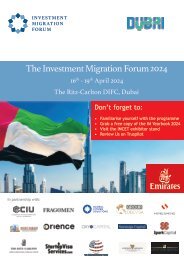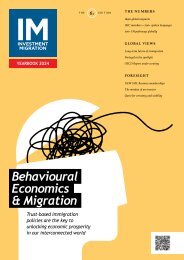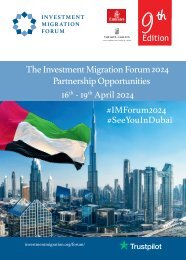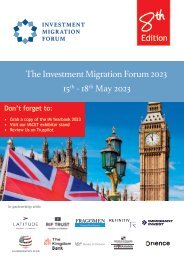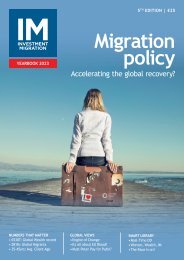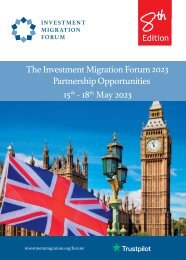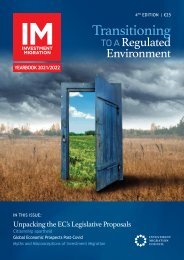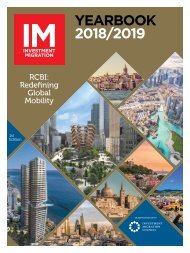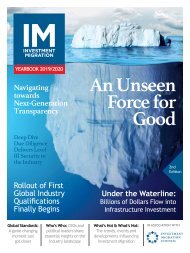IM Yearbook 2020/21
Born from the need for a global, credible, “go-to” publication, the 3rd IM Yearbook offers valuable access to a prime target audience of top industry influencers, decision makers, and the foremost referral network to the world’s most influential Investment Migration programmes: Government officials such as Heads of CIU’s, policy makers, academics, migration agents, law firms, wealth managers, financial advisors, real estate developers, and international firms involved in investment migration.
Born from the need for a global, credible, “go-to” publication, the 3rd IM Yearbook offers valuable access to a prime target audience of top industry influencers, decision makers, and the foremost referral network to the world’s most influential Investment Migration programmes: Government officials such as Heads of CIU’s, policy makers, academics, migration agents, law firms, wealth managers, financial advisors, real estate developers, and international firms involved in investment migration.
You also want an ePaper? Increase the reach of your titles
YUMPU automatically turns print PDFs into web optimized ePapers that Google loves.
in 1975, China was a desperately poor<br />
country. So, Asia has always been much<br />
more than China. Then we saw the rise<br />
of the tiger economies - Singapore, Hong<br />
Kong, South Korea, and Taiwan, which<br />
became spectacularly rich as well. China<br />
was still backwards. We can say that Japan<br />
represents the first wave of Asian growth,<br />
the Tigers the second wave, and China is<br />
only the third wave of growth. For many<br />
people in the West, China is the beginning,<br />
the middle and the end. China is Asia.<br />
That’s not true, and it has never been true.<br />
No empire has ever dominated Asia, with<br />
one single exception and that was the<br />
Mongol Empire. And Asia’s rise continues<br />
as we are now witnessing the fourth wave<br />
of growth, which is Southeast Asia.<br />
What are the drivers behind<br />
Southeast Asia’s growth?<br />
South and Southeast Asia have a<br />
combined population of more than 2.5<br />
billion people, a billion more than China,<br />
with a population that is also younger. I<br />
believe Southeast Asia’s growth will even<br />
be greater than China’s. If 2.5 billion are<br />
getting connected, benefit from better<br />
urbanization, of course, those countries<br />
are going to grow rapidly. In fact, the<br />
GDP of that set of countries will equal<br />
China’s GDP in less than a decade.<br />
So, the problem with our discourse<br />
about Asia is that we can’t really ask<br />
who else matters. All Asian countries<br />
matter and are important at the same<br />
time. Asia has always been multipolar<br />
because it is home to many diverse,<br />
rich, deep civilisations in one region.<br />
China as well as the countries in<br />
Southeast Asia are key source markets<br />
for the investment migration industry.<br />
With those countries becoming<br />
richer and growing in geopolitical<br />
importance, do you believe Asians<br />
will still be interested in investment<br />
migration in 10 years’ time?<br />
That’s a good question, and I think the<br />
answer is yes. The reason for it is that<br />
there are as many different motivations<br />
behind investment migration as there are<br />
Asians. I envision a future where instead<br />
of us seeing many Chinese people in the<br />
West, we will see a lot more Indians in<br />
the West. That’s going to be one of the<br />
big shifts in the years ahead. I also don’t<br />
think the Chinese will lose their appetite<br />
for investment migration. Let’s not forget<br />
that even though China is wealthy, the<br />
Chinese have a long list of concerns,<br />
including tax policy, anti-corruption drive<br />
and political regulation activities. Climate<br />
change, which is going to affect large parts<br />
of China, India and Indonesia, will also<br />
influence Asian’s decision to migrate.<br />
At the same time, we are seeing labour<br />
shortages in the West, where governments,<br />
given the declining populations in their<br />
countries, will need to shore up the<br />
demographic foundation and attract people<br />
to build the tax base. Investment migration<br />
is one option to do that. So, I believe that<br />
from the supply side and the demand side,<br />
there is going to be significant opportunity<br />
and movement in the years ahead.<br />
Human rights groups regularly criticise<br />
Southeast Asian governments. What’s<br />
your opinion on this issue and what<br />
can the West learn from the East?<br />
In Asia, there’s a strong focus on<br />
technocratic governance. We have no<br />
patience for bad leaders. They get thrown<br />
out. Technocratic governance is what Asian<br />
people want. That’s how Narendra Modi<br />
got elected in India. Yes, he is controversial,<br />
but he is also someone who gets things<br />
done. He said: we are going to build ten<br />
thousand kilometres of railways, clean<br />
up the streets, defend our borders, and<br />
stand up for ourselves. That’s what makes<br />
him the most popular leader. Then there<br />
is Rodrigo Duterte, the President of the<br />
Philippines. In Western eyes, he is even<br />
worse. I am not defending him, I am<br />
simply pointing out that if a guy comes<br />
along who says I am going to end poverty<br />
and corruption on every level, and I am<br />
going to fix electricity, build hospitals and<br />
guarantee education, then of course people<br />
vote for him. For developing countries, it<br />
is better to be technocracies as they need<br />
to make structural changes fast. They<br />
can’t afford to make endless mistakes.<br />
Let’s also keep in mind that technocracy<br />
is a European idea. Germany is a<br />
technocratic country but it’s also a liberal<br />
democracy. These two are not opposing<br />
concepts. But the issue is that most Western<br />
countries are not like Germany. Germany<br />
is the most Asian country of all Western<br />
countries. And Asian countries aspire to be<br />
like Germany. They don’t aspire to be like<br />
the US or the UK. Education, industrial<br />
policies, export, vocational training – in<br />
all of these critical areas of state-building,<br />
Asian countries want to be like Germany.<br />
I am fierce critic of Asian Governments’<br />
approach to censorship as way to silence<br />
critics, and I am not championing it at<br />
all. It’s wrong, but at the same time, they<br />
have adopted an incremental approach<br />
to liberalizing discourse in a way that<br />
does not lead to tension, and that’s<br />
how you can maintain multi-ethnic<br />
states and peace at the same time.<br />
I envision a<br />
future where<br />
instead of us<br />
seeing many Chinese<br />
people in the West,<br />
we will see a lot more<br />
Indians in the West.<br />
In your opinion, which investment<br />
migration programmes are most<br />
appealing to Asians at the moment?<br />
I think all countries that promise stability are<br />
very attractive. If you are in Asia right now,<br />
you are worried about China-US tensions,<br />
territorial disputes in the South China<br />
Sea or the potential for conflict between<br />
Taiwan and China or between China and<br />
India. Those are very valid concerns. In<br />
my opinion, Europe is the winner, with its<br />
focus on sustainability, independence and<br />
welfare. In addition, the euro offers a very<br />
important diversification hedge from a<br />
dollar that is being devalued, while Europe’s<br />
action to stop climate change is also an asset.<br />
So, investment migration programmes in<br />
Europe are definitely appealing to Asians.<br />
While America, Canada and the UK<br />
were the recipients of the first wave of<br />
outbound Asians in the post-war decade,<br />
I am fairly certain that the next wave is<br />
much more likely to go to Europe.<br />
Parag Khanna is a<br />
BIO leading global strategy<br />
advisor, world traveler<br />
and best-selling author.<br />
He is Founder & Managing<br />
Partner of FutureMap, a data<br />
and scenario based strategic<br />
advisory firm. Parag’s newest<br />
book is The Future is Asian:<br />
Commerce, Conflict & Culture<br />
in the <strong>21</strong>st Century (2019).<br />
Investment Migration <strong>Yearbook</strong> 2O2O/2O<strong>21</strong> 101




